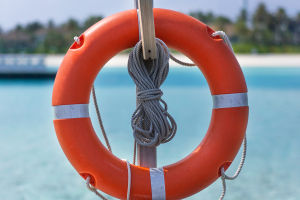The U.S. Coast Guard released concerning statistics on recreational boating accidents, reporting 4,168 incidents across the nation, resulting in $55 million in property damage.
When faced with distress on the water, knowing how to signal for help is paramount for boaters and drivers alike.
While electronics, pyrotechnics, and manual methods are commonly employed, having the skills to seek assistance is crucial in emergency situations.
1. Pyrotechnic Flares: Boats compliant with safety regulations typically include a set of flares in their onboard kit. Understanding the different types and their usage is vital. Flares are categorized into daytime and nighttime variants, available in floating, handheld, and aerial versions.
2. Floating: These smoke signals are deployed on the water, emitting orange-colored smoke exclusively during daylight hours. Lasting a few minutes, they remain visible for up to 5 miles, aiding nearby boats or rescuers in locating distress.
3. Handheld: Providing both orange smoke signals and bright daytime flares, handheld flares serve as visual markers for nearby vessels when assistance is required. Alternatively, handheld pyrotechnic flares, usable day or night, can be shot into the air for increased visibility. Although they burn briefly, they effectively attract attention from authorities or nearby boats.
4. Aerial: Fired from handheld orange pistols, these pyrotechnic flares ascend higher, visible from approximately 21 miles away for up to 6 seconds. Rocket parachute flame signals, adhering to SOLAS convention standards, are detectable from 47 miles and burn for 40 seconds. Caution must be exercised during handling, as mishandling can lead to burns from hot slag. Flares have a shelf life of 42 months and must be replaced and disposed of appropriately.
5. Signal Flares: In daylight, an orange distress flag measuring 3 x 3 feet, featuring a black square atop a black circle, serves as a distress signal.
6. Alternative Signaling Methods: When conventional methods fail, several alternatives can still prove effective. Brightly colored clothing attached to a boat hook, paddle, or oar can be waved from the deck's highest point. Waving arms from head to hips is a recognized distress signal, while flashing a flashlight or spotlight rapidly at night can attract attention. Additionally, sounding the horn may alert nearby vessels, even if visual cues are not discernible.
Modern technology offers a range of electronic distress beacons that transmit distress signals via satellite. Emergency Position Indicating Radio Beacons (EPIRBs) and Personal Locator Beacons (PLBs) are compact, portable devices that can be activated in emergencies, providing accurate location information to search and rescue authorities. These devices are invaluable for boaters venturing into remote or offshore waters where traditional signaling methods may be less effective.
Boaters should familiarize themselves with distress signals recognized by international maritime law, such as the Morse code SOS signal (three short, three long, three short), which remains a universal call for help. Knowledge of these signals can facilitate communication with other vessels and expedite rescue efforts in distress situations.
Boating safety courses and training programs often include instruction on distress signaling techniques, empowering boaters with essential skills and knowledge to navigate emergencies effectively. By staying informed and prepared, boaters can enhance their safety on the water and minimize risks associated with recreational boating.


